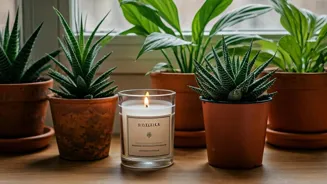Candles: A Closer Look
Scented candles, widely used for their appealing fragrances, are now a topic of growing concern in the medical community. These candles often release volatile
organic compounds (VOCs) into the air, which can significantly impact indoor air quality. The very ingredients that give candles their scent, along with the burning process itself, contribute to the emission of chemicals that may be hazardous to human health. These chemicals can include formaldehyde, benzene, and toluene, all of which have been linked to various health issues. The choice of candle wax, whether paraffin, soy, or beeswax, along with the types of fragrances and dyes, influences the specific compounds released, thus affecting the indoor environment's safety.
Air Quality Impact
Indoor air quality plays a critical role in overall health and well-being, and the use of scented candles can negatively affect it. When a candle burns, it introduces particles and gases into the air. The burning process releases pollutants that can irritate the respiratory system, especially for those with asthma or allergies. The composition of the candle—particularly the wax, fragrance oils, and additives—influences the severity of the air quality degradation. The burning of paraffin wax, a common ingredient, is known for producing soot and releasing more pollutants compared to natural waxes like soy or beeswax. Frequent and prolonged use of these candles can therefore lead to a buildup of indoor air pollutants, potentially causing or worsening respiratory symptoms.
Health Risks Unveiled
Doctors express concern about the potential health risks related to the widespread use of scented candles, mainly due to the emission of harmful chemicals during burning. Prolonged exposure to these chemicals can exacerbate respiratory issues, triggering asthma attacks or allergic reactions in sensitive individuals. Moreover, some compounds released by burning candles, like benzene, are carcinogenic and can elevate the risk of cancer with sustained exposure. Studies have linked these candles to a range of health complaints, including headaches, dizziness, and nausea, highlighting the need for careful evaluation of their use. Given the evidence, healthcare professionals often suggest avoiding these candles to protect overall well-being and reduce the exposure to potentially toxic substances.
Healthier Alternatives Explored
Fortunately, several healthier alternatives exist for enhancing the scent of your home without compromising air quality. Essential oil diffusers are an excellent option. They disperse natural essential oils into the air, providing fragrance without the emission of harmful chemicals associated with candles. Choosing oils with natural scents, like lavender, eucalyptus, or citrus, can also offer additional therapeutic benefits such as relaxation or improved mood. Other alternatives include beeswax candles, which produce less soot and fewer toxins compared to paraffin candles, and natural potpourri, which releases a gentle scent without combustion. Finally, opening windows regularly to ventilate your home can significantly reduce indoor air pollutants, improving overall air quality alongside these safer scenting methods.
Making Informed Choices
Making informed choices regarding scented candles requires understanding their potential impacts and exploring safer alternatives. Always check candle labels for the wax type, fragrance ingredients, and any potential additives, ensuring that the product contains natural waxes like soy or beeswax, and fragrance oils free from harmful chemicals. When choosing a candle, look for options that use natural essential oils instead of synthetic fragrances. Always ensure adequate ventilation when burning candles and avoid burning them for extended periods in enclosed spaces. If you experience respiratory symptoms or headaches after using a candle, discontinue use and consider alternative scenting methods. By carefully selecting candles and being mindful of their use, you can create a pleasant environment while minimizing potential health risks, thus promoting a healthier home atmosphere.













